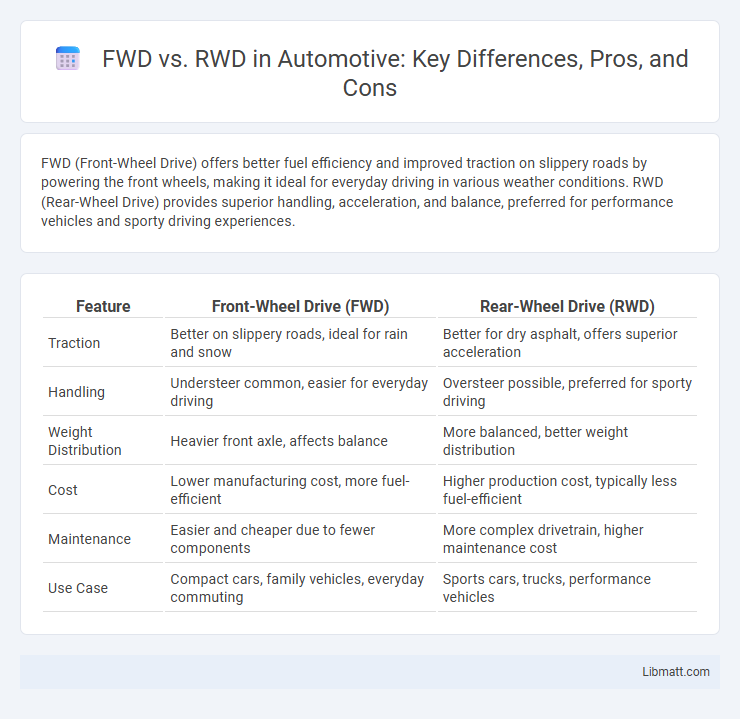FWD (Front-Wheel Drive) offers better fuel efficiency and improved traction on slippery roads by powering the front wheels, making it ideal for everyday driving in various weather conditions. RWD (Rear-Wheel Drive) provides superior handling, acceleration, and balance, preferred for performance vehicles and sporty driving experiences.
Table of Comparison
| Feature | Front-Wheel Drive (FWD) | Rear-Wheel Drive (RWD) |
|---|---|---|
| Traction | Better on slippery roads, ideal for rain and snow | Better for dry asphalt, offers superior acceleration |
| Handling | Understeer common, easier for everyday driving | Oversteer possible, preferred for sporty driving |
| Weight Distribution | Heavier front axle, affects balance | More balanced, better weight distribution |
| Cost | Lower manufacturing cost, more fuel-efficient | Higher production cost, typically less fuel-efficient |
| Maintenance | Easier and cheaper due to fewer components | More complex drivetrain, higher maintenance cost |
| Use Case | Compact cars, family vehicles, everyday commuting | Sports cars, trucks, performance vehicles |
Introduction to FWD and RWD
Front-Wheel Drive (FWD) vehicles transmit engine power directly to the front wheels, enhancing traction in slippery conditions and improving fuel efficiency by reducing drivetrain weight. Rear-Wheel Drive (RWD) systems deliver power to the rear wheels, offering balanced weight distribution and superior handling dynamics favored in performance and sports cars. Both drivetrain layouts influence vehicle stability, acceleration, and driving experience based on road conditions and design priorities.
Understanding Drivetrain Layouts
Front-Wheel Drive (FWD) vehicles position the engine's power directly to the front wheels, enhancing fuel efficiency and interior space by reducing drivetrain complexity. Rear-Wheel Drive (RWD) channels power to the rear wheels, offering superior handling, acceleration, and balance, especially in performance and sports cars. Understanding drivetrain layouts helps in selecting the right vehicle based on driving conditions, performance needs, and maintenance preferences.
Key Differences Between FWD and RWD
Front-Wheel Drive (FWD) vehicles deliver power to the front wheels, offering better traction in slippery conditions and improved fuel efficiency due to lighter drivetrain components. Rear-Wheel Drive (RWD) systems send power to the rear wheels, providing superior handling, balance, and acceleration, especially in performance and sports cars. Understanding the key differences between FWD and RWD can help you choose the drivetrain that best suits your driving preferences and conditions.
Performance Comparison: FWD vs RWD
Front-Wheel Drive (FWD) vehicles typically offer better traction in slippery conditions due to the engine's weight over the driven wheels, enhancing stability during acceleration. Rear-Wheel Drive (RWD) delivers superior handling and balanced weight distribution, making it preferred for high-performance driving and sharp cornering. Your choice between FWD and RWD impacts vehicle dynamics, with RWD providing improved responsiveness and FWD excelling in everyday driving stability.
Handling and Stability
FWD vehicles offer better traction in slippery conditions due to the engine's weight over the front wheels, enhancing stability during acceleration and cornering. RWD cars provide superior handling dynamics with balanced weight distribution and improved steering response, allowing your vehicle to perform better in high-speed maneuvers and tight turns. Choosing between FWD and RWD affects your driving experience, where stability favors FWD and agile handling leans towards RWD.
Fuel Efficiency and Maintenance
FWD (Front-Wheel Drive) vehicles typically offer better fuel efficiency due to lighter drivetrain components and reduced mechanical losses compared to RWD (Rear-Wheel Drive) systems. Maintenance costs for FWD cars tend to be lower since the drivetrain is more compact and less complex, leading to fewer parts subject to wear. Your choice between FWD and RWD can impact long-term fuel consumption and repair expenses depending on driving conditions and vehicle design.
Cost Considerations
Front-Wheel Drive (FWD) vehicles generally offer lower manufacturing and maintenance costs due to fewer drivetrain components and simpler layouts, making them more budget-friendly for buyers. Rear-Wheel Drive (RWD) systems often involve higher production expenses and more complex maintenance because of additional parts like a driveshaft and differential, increasing overall ownership costs. You can save significantly on initial purchase price and routine upkeep by choosing FWD, especially if cost efficiency is a priority.
Use Cases: Best Applications for FWD and RWD
Front-Wheel Drive (FWD) excels in compact cars and daily commuters due to its efficient packaging, better fuel economy, and enhanced traction in wet or snowy conditions, making it ideal for city driving and moderate climates. Rear-Wheel Drive (RWD) is preferred in performance vehicles, trucks, and sports cars where superior handling, weight distribution, and towing capabilities are crucial, especially on dry roads or for spirited driving. Your choice between FWD and RWD should align with your driving environment and performance needs to maximize vehicle efficiency and control.
Pros and Cons of FWD and RWD
Front-Wheel Drive (FWD) offers better fuel efficiency and improved traction in slippery conditions due to the engine's weight over the driving wheels, but it may suffer from understeer and reduced handling dynamics. Rear-Wheel Drive (RWD) provides superior balance and handling performance, especially in high-power vehicles, with improved acceleration and cornering capabilities, yet it can be less effective on wet or icy roads and often results in lower fuel economy. Choosing between FWD and RWD depends on priorities such as driving conditions, performance needs, and fuel efficiency preferences.
Choosing the Right Drivetrain for Your Needs
Front-Wheel Drive (FWD) offers improved fuel efficiency and better traction in wet or snowy conditions, making it ideal for everyday commuting and urban driving. Rear-Wheel Drive (RWD) provides superior handling and acceleration, favored for performance vehicles and driving enthusiasts seeking dynamic control. Selecting between FWD and RWD depends on your typical driving environment, performance preferences, and maintenance considerations.
FWD vs RWD Infographic

 libmatt.com
libmatt.com